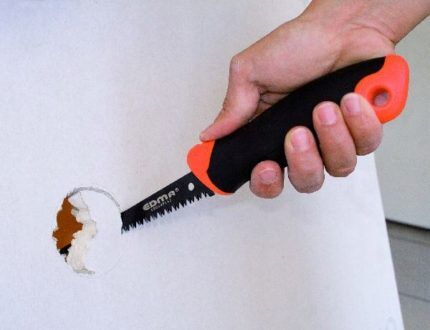How to cut drywall at home: tools and cutting methods
Are you planning to cover your walls or ceiling with plasterboard? Perhaps you have plans to design complex shapes from this universal material? In any case, you won’t be able to get by with just whole sheets, so it’s important to know how to cut drywall at home and what you need for this.
Drywall is an easy-to-use material; almost any structure can be built from it. Even a beginner can cut it without a special tool. Professionals have their own methods and tools to make cutting large quantities of sheets quick, easy and accurate.
In this article we will look at all the variety of tools, both for the home craftsman and for real professionals. We'll tell you how to cut drywall into even strips, make a hole in it, and give the sheet or slot any shape. As a bonus, we'll show you how to easily clean the house after this dusty task.
The content of the article:
Choosing the right tool
Drywall combines high load-bearing capacity with ease of processing: it can be cut and sawed with almost anything.
So that you can choose the best option, we will describe the main devices, their advantages and disadvantages.
To mark the cutout
It is best to mark the cutting line on the sheet with a simple pencil - a clerical one, or a thicker construction one.
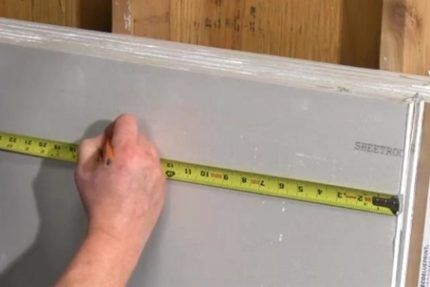
It is most convenient to measure the required dimensions, the distance from the edge of the sheet to the cutout, with a tape measure.
To keep the lines straight, draw them under a rule or a long ruler. For perpendicular intersections, use a square, and for round holes, you may need a compass.
Hand sawing and cutting tools
Stationery or construction knife - the simplest, most accessible and popular cutting tool drywall. It is used by both beginners and professionals. The knife cuts the cardboard, and the gypsum layer breaks.
The method is simple, creates a minimum of dust, and the edges of the cardboard are smooth. Among the disadvantages - the uneven edge of the gypsum layer sometimes requires modification; it will not be possible to make a round hole or cut a sheet fixed on the wall.

A knife usually makes an even cut, that is, the sheet can be reduced or dissolved into strips. It will be problematic to make more complex shapes with this tool, but it is possible.
Hacksaw – a universal option, it cuts through the sheet, can be used for holes and lines of any shape, before or after installing drywall. At the same time, it is inexpensive and can be found in almost every home. It is better to choose a hacksaw for metal - its small teeth do not tear cardboard, and the thin blade bends at the curves.
Specialized drywall hacksaw The "fox" has a pointed nose for driving into the leaf or teeth on both sides of the blade.
Disc blade cutters are able to cut through cardboard from both sides of the sheet at once absolutely symmetrically, in one pass. It's fast and convenient, but not everyone has such a tool. They are used for cutting only before the stage of material installation. U-shaped models with a parallel stop will help cut the strip, but its width is limited by the maximum length of the tool.
Magnetic cutters consist of two separate soles that are magnetically attracted to each other through the sheet. To guide the magnetic disk cutter for drywall exactly along the marking line, you will need training or additional equipment.

You will need a hammer if you need to make a hole in drywall, and you have nothing but a knife. The result is not very neat, but sometimes this is enough.
Power tool for cutting drywall
Using a universal power tool, drywall is cut with a jigsaw with a blade for metal or a hand-held circular saw with a disk for wood. You can cut several sheets at the same time, which significantly speeds up the work. For straight strips, it is convenient to use a parallel fence - it is usually included in the tool kit.
The cut is smooth, but at high speed or with a dull canvas, the cardboard can be undermined, resulting in a fringe. The main disadvantage of these tools is that they create a lot of plaster dust: it’s hard to breathe and it’s hard to clean the house afterwards.
It is also not always convenient to position a large sheet of drywall so that it does not break, and there is space under the cut for the saw to move freely.
A circular saw - the only tool that can easily cope not only with drywall, but also with profiles. This will help if you need to cut a hole that was not foreseen during the sheathing and now it ends up on the profile.
Reciprocating saw - a rarer tool, very similar to a jigsaw, but capable of cutting with virtually no support: the sheet may not be secured, stand vertically or at an angle. The tool is cordless and independent of outlets, but the cut is less accurate.
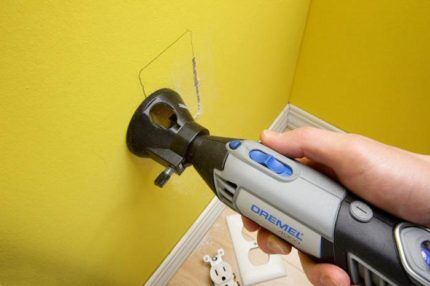
Drill or screwdriver with various attachments they are used for round cutouts, as well as for the starting hole for a hacksaw blade.
Feather drill, often used when installing wooden doors or windows, is suitable for small diameter holes. The maximum pen size is 60mm, but up to 25–35mm are often used, for example, for wiring.
Crown – a metal cylinder with a pilot drill in the center. Used for round holes up to 10cm in diameter.
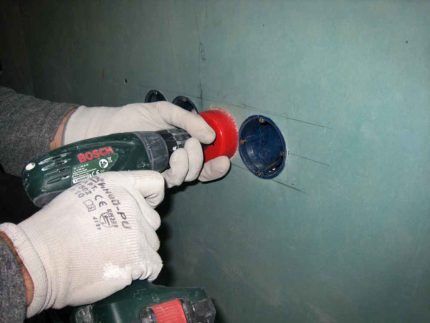
The ballerina attachment will help you cut a hole up to 40cm in diameter - for example, for a fan. Its basis is a crosspiece, on the shoulders of which blades are attached. By moving the knives, you can change the diameter of the hole.
How to straighten the cut?
The edge of a plasterboard sheet, mounted end-to-end or forming a corner, is usually covered with putty through a reinforcing mesh or corner. This means that any cut irregularities and cracks will be hidden, no additional processing is needed.
If there are bulges on the cut that interfere with installation, or for some reason the protrusion will be covered with putty without using a corner, the edge of the sheet is leveled with the following tool:
- roughing plane, rasp;
- sandpaper;
- stationery or construction knife;
- file.
Choose a tool depending on the shape of the cut and what is at hand.
Methods for cutting drywall
To cut drywall evenly, accurately, without ruining a single sheet, you need to know some rules.
In this section we will look at how to use the tool described above in each specific case.
Method No. 1 - straight cutting
Such a cut is necessary in any repair: after most of the area is covered with whole sheets, stripes and small rectangles will inevitably be needed to fill gaps, as well as create decorative structures.

Most often, strips of drywall are cut with a knife. The procedure is as follows:
- Measure the required width on the wall.
- Mark this distance on a sheet of drywall and place marks on its back side.
- Apply the rule to the marks, draw a line.
- Pressing the rule tightly, cut through the cardboard and the top layer of plaster along it. Drive the knife with pressure several times.
- Break the sheet along the cut line so that the cut opens.If the material lies on a table or other elevated surface, move it with the cut to the edge of the table; if the sheet is standing, fold it by pulling the edges with your hands and hitting the whole, uncut side with your knee.
- Cut through the cardboard layer from the second, front side, along the resulting fold line.
- If necessary, trim the edge of the plaster layer with a knife or plane.
Using specialized disc cutters, you can cut through 2 layers of cardboard at once: all that remains is to break the sheet.
If you combine them with a parallel stop, you also save time on marking.
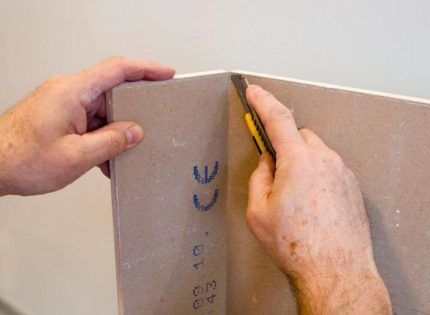
If you need to cut arched plasterboard reinforced with fiberglass, or cut through several sheets at once, use a jigsaw or a hand-held circular saw. It also makes sense to cut with a jigsaw along the rip fence if high precision is required.
In other cases, the choice of hand or power tools is a matter of taste. The speed of work with a certain skill with a knife can be even higher, and besides, it does not raise a cloud of dust.
When cutting with a jigsaw, select a metal blade and move the tool slowly. It is better to draw the markings with a marker so that they can be seen through the dust, but only on the back side of the sheet.
A hand hacksaw or saw is rarely used for long, even cuts - this is not rational.
Method No. 2 - rectangular and square holes
The easiest way is to cut a rectangle or square for communications or an inspection hatch on the edge of the sheet.
For this:
- Apply markings.
- Use a hand saw or jigsaw to cut the edges perpendicular to the edge.
- Cut the cardboard along the remaining edge with a knife.
- Hit the resulting door, breaking it.
- Cut through the second layer of cardboard.
If the hatch is in the middle of the sheet, it is convenient to cut it out after fixing the sheet to the wall. To insert a regular hacksaw into a sheet, one or more holes are drilled in a row.
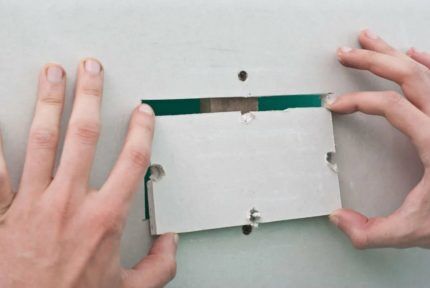
It is convenient to use a hacksaw for drywall - a fox. Its sharp nose is driven into the sheet until it goes right through, and then sawed along the marking line. For each edge, the saw is driven into the sheet again, with a new direction for the blade.
A reciprocating saw will do a great job of cutting drywall already on the wall, if you have one.
Use a grinder to cut out such holes if they are on a metal profile. Each cut is longer than the edge of the hole. It's not scary - the extra cracks will be hidden with putty.
Method number 3 - round holes
A circle of small diameter is usually cut out after installing drywall on a wall or ceiling.
The fastest way to make a cut is with a drill or screwdriver. Depending on the diameter of the hole, a feather drill, a crown or a ballerina drill is used. In this case, marking the entire circle is not necessary: just a point in the center for a guide drill is enough.
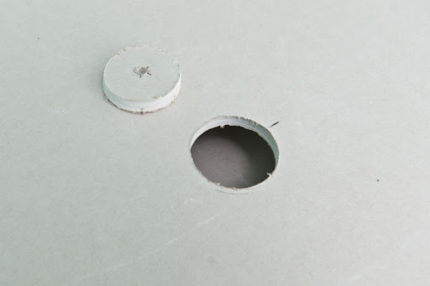
You can get by with a hand hacksaw if its blade is narrow enough to turn. The markings are applied using a compass, or they are drawn around the box with a pencil, socket box, for which the cutout is intended.
Then drill a hole for the hacksaw blade and carefully saw through the drywall according to the markings. If the saw has deviated significantly from the intended line, start cutting in the opposite direction from the starting hole.
This method most often produces holes of non-ideal geometry. They can be easily modified using sandpaper or a file, cutting the cardboard with a knife.
Method number 4 - cutting without tools
When you need to make a cut, but there is no special hacksaw or other tool, you can get by with a knife and a hammer. The scheme is simple: you need to cut through the cardboard and the top layer of plaster on one side of the sheet, tap with a hammer along the edge of the figure, squeezing it out. Then cut through the cardboard from the back side along the contour of the convexity, finally squeeze out the figure, freeing the hole.
With this treatment, the gypsum layer along the contour of the cutout crumbles, so the edge turns out to be sloppy and soft. This can be easily fixed with putty.
Method No. 5 - figured cutting
You can create figures of any intricate shapes from drywall.
Large radius bends are cut with a jigsaw or a hand saw. To do this, the sheet needs to be conveniently placed on a hill: 2 chairs, stacks of other sheets, or something similar. Make sure that the support area is sufficient and the sheet does not break under its own weight.
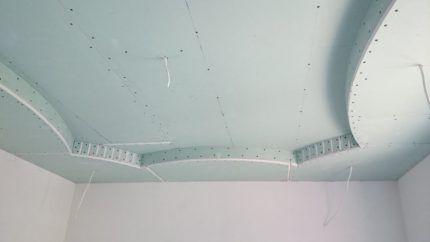
Mark the sheet, for example, by tying a pencil to a thread, fix the second end of the thread in the center and draw a circle. Complex shapes are drawn by hand or using a template.
Move the jigsaw or hacksaw along the markings slowly and with minimal pressure so as not to break the sheet. First, go around the sharp corners smoothly: you will finish them on the finished figure with a hacksaw, file or knife.
Some shapes, especially angular ones, are more convenient to cut using a knife according to a pattern. Procedure:
- make a pattern - a model of the figure that needs to be cut out. It is better to use wooden boards;
- measure the location and trace the pattern with a pencil on one side of the drywall;
- drill a through hole in several corners of the figure;
- Focusing on the holes, attach and trace the figure on the other side of the sheet with a pencil. For asymmetrical figures, do not forget to turn the workpiece over, mirroring the image;
- check whether the drawings on both sides of the sheet match;
- Attach the pattern again and cut the sheet with a knife exactly along the contour as deep as possible;
- repeat on the other side of the sheet;
- carefully squeeze out or knock out the cut out shape with a hammer;
- Use a knife or file to refine the cut lines and corners.
Sometimes it makes sense to make a complex-shaped cutout after the sheet is fixed. The ideal tool for this type of work is a reciprocating saw.
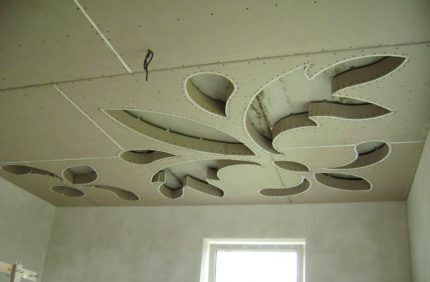
The location of the cutout should be anticipated before attaching the drywall to the wall or ceiling, so as not to get the sheet onto the metal profile later.
How to remove gypsum dust?
When cutting drywall, very fine dust is generated, which is then difficult to remove. It leaves white stains on smooth surfaces even after you wash the floor for the 3rd time, but it packs into porous or grooved surfaces very tightly and reliably.
The easiest way is to prevent pollution. When using a jigsaw or other power tool, connect it to vacuum cleaner. As a rule, there is a special round connector on the back of the case.
Cover the floor with newspapers or oilcloth. If you wet them, the dust will settle and hold better, but if moisture gets on the drywall, it can ruin it.
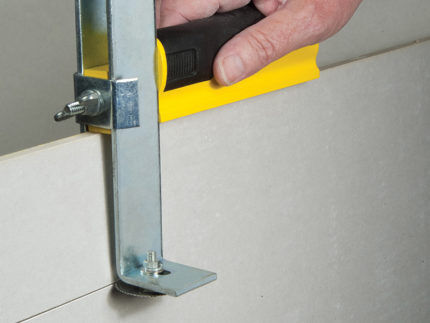
Before mopping the floor, vacuum up the bulk of the plaster.
To clean porous or matte coatings - porcelain tiles, textured linoleum - prepare a mixture of vegetable oil and water. The ratio is 1:100, that is, 100 ml of oil per 10-liter bucket. By washing the floor with this solution, you will draw particles of the floor from the pores and cavities: they will all collect in an oil film on the surface. You can finally clean the floor with a vinegar solution.
A glossy floor, such as a tiled floor, will get rid of white stains with a warm light pink solution of potassium permanganate.
Conclusions and useful video on the topic
This video shows a tool for quickly cutting strips based on a magnetic disk cutter:
Here is a multifunctional construction knife - a cutter with a built-in tape measure:
The main ways to make a hole in drywall are shown in detail in this video:
Cutting drywall, even without experience and special tools, is quite a feasible task for a home craftsman. However, using some tricks and devices, you can make this work easier and faster, and also cut out the most intricate shapes.
Have you ever encountered the need to cut drywall? What tool did you use, were you satisfied with the result? Join the discussion of the article in the comments.
